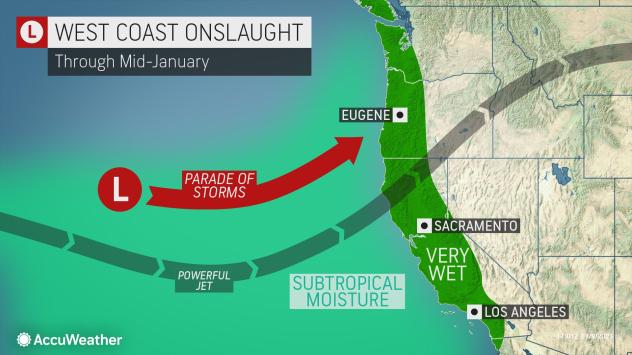
No Rest For The Weary: More Flooding Rain To Eye California

AccuWeather meteorologists say that more rain is in the forecast for California, as additional storms from the Pacific are expected to reach the western United States in the coming days.
Multiple large and powerful storms have hit California since New Year’s Eve, making for a disastrous start to 2023 for the state. The most recent California storm killed at least three people and dumped nearly 10 inches of rain on southern parts of the state and around 2 feet of snow in the Sierra Nevada.
Forecasters say the active pattern in the western U.S. will continue, and at least another pair of storms is set to pummel the region in the coming week. These additional waves of moisture will tap into a substantial atmospheric river, bringing additional flooding risks.

“While the wave of moisture aims for Oregon, parts of Central and Southern California will get a break from the heavy rainfall,” explained AccuWeather Meteorologist Joseph Bauer.
The rain will start to move onto the coast Wednesday and persist through Friday. Widespread rainfall amounts of 1-3 inches are expected from southwestern British Columbia through western Washington, Oregon and Northern California. In southwestern Oregon and Northern California, several inches of rain are expected, and a few areas could receive more than 6 inches of additional rainfall.
California Governor Gavin Newsom said 12 people had been killed as a result of the violent weather in the past 10 days.
More than 120,000 homes in California were left without power early on Monday, according to data from PowerOutage.us.
Last week’s storms disrupted road travel with flash floods, rock slides, and toppled trees.
The parade of storms has opened sinkholes capable of swallowing cars, caused numerous landslides, turned roadways into waterways, toppled countless trees, buried mountain towns in snow and left more than 130,000 homes and businesses without power.
“We expect these storms to continue at least through the 18th of this month,” Newsom said. “The magnitude of this is not isolated in smaller communities. It is scaled across the largest state in our union.”

“The active pattern [is] great news across the mountain ranges, in terms of building snowpack for later use; however, the heavy rain, gusty winds and snow will all be impactful to California,” Bauer warned.
The relentless rainfall will renew the risks of flooding and landslides which could bring additional road closures. Precipitation is expected to fall as snow in the higher elevations, including in the Sierra Nevada and the Cascades. However, the fluctuation of rain and snow could bring an increased avalanche danger as well.
The second storm will move into the West Coast in time for the weekend and may pack more of a punch for the remainder of California.
“More precipitation is expected to spread across the majority of California again on Saturday,” Bauer said about the second storm.
The storm is expected to bring more flooding risks to the region as well as another round of gusty winds. This combination, following the astounding rainfall amounts already recorded in the state, could bring more damage to a beleaguered state already reeling from numerous mudslides and flood impacts.

“Tree damage and power outages could be more extensive with how wet the ground is already,” Bauer said.
Through Jan. 9, downtown Los Angeles has picked up 3.97 inches of rain, which is 121 percent of normal for the city during the entire month. San Francisco has reported 4.01 inches of rain in the same time, which is 91 percent of normal for the month of January and nearly three times the normal rainfall in the first nine days of the month.
Airline travelers are likely to face another round of delays and possible cancelations at the major hubs of San Francisco and Los Angeles. Even airports that are not directly impacted by this storm can face a backlog of flights as crews and aircraft are displaced.
The weekend storm is likely to be rather quick-moving, with drier conditions expected by Sunday. However, rain and snow showers are forecast to expand into parts of Nevada, Utah and Arizona by the second half of the weekend.
Additional rounds of rain could be on the docket for California through the middle of the month as the current La Niña pattern continues to weaken, which would favor less intense storms overall and a general trend toward a northerly storm track along the West Coast. Still, some rounds of precipitation could sweep into the Golden State.
Produced in association with AccuWeather.
The Western Journal has not reviewed this story prior to publication. Therefore, it may not meet our normal editorial standards. It is provided to our readers as a service from The Western Journal.
Truth and Accuracy
We are committed to truth and accuracy in all of our journalism. Read our editorial standards.
Advertise with The Western Journal and reach millions of highly engaged readers, while supporting our work. Advertise Today.












